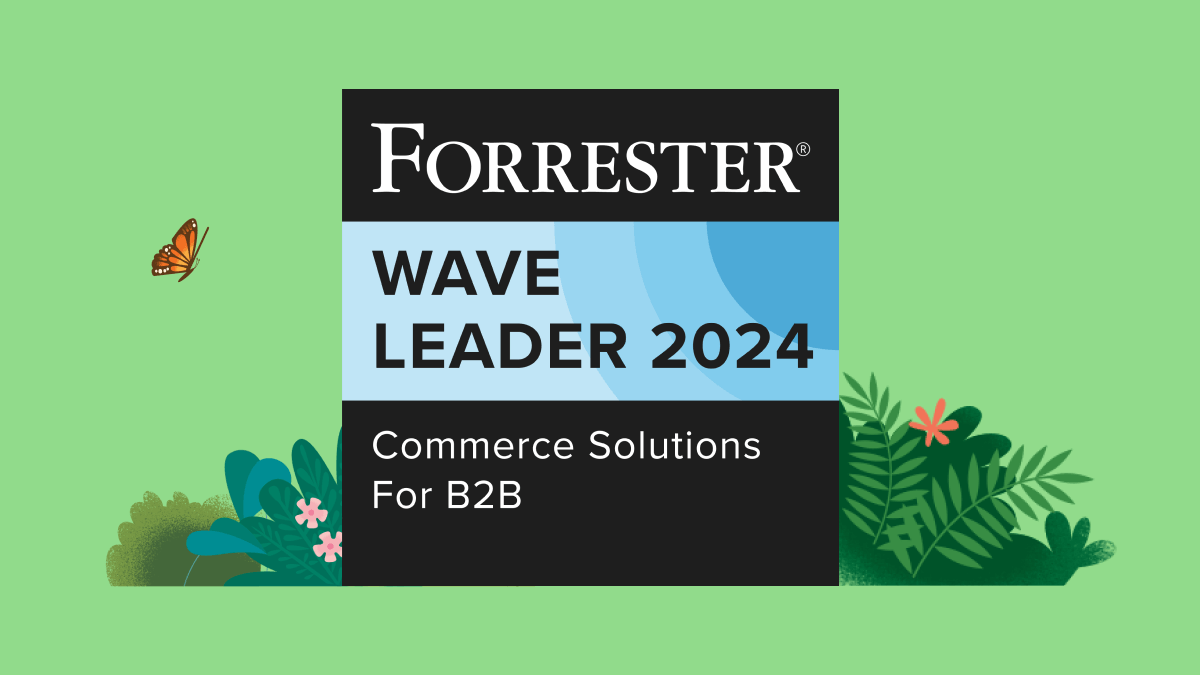The B2B Digital Commerce Playbook
How to launch quickly, keep costs low, and maximize your efforts.
Editorial Lead, Commerce Cloud
Customer relationships have always been the north star of a successful B2B organization. But as technology advances and buyer expectations skyrocket, the dynamics of those relationships are shifting.
B2B buyers want to interact with business sellers the same way they interact with retail brands as consumers. More and more, that means new channels, self-service options, and hyper-personalized experiences. Digital commerce is now table stakes for B2B companies. In fact, B2B sellers expect more than half (53%) of their revenue to come from digital channels within the next two years.
If you want to boost sales and strengthen customer relationships in an increasingly digital B2B world, it’s critical to build compelling online experiences. In the midst of budget cuts, the rise of AI, and competing business priorities, it can be difficult to know where to start.
The good news? Whether you’re starting from scratch or replacing an aging legacy platform, we have a few practical steps that will help you get your digital storefront up and running — quickly and cost-effectively.
Chapter 1
Drive Efficiency and Minimize Costs with a Phased Approach
Start with your top priorities to maximize your efforts.

Every software implementation should begin with a clear vision for the challenges it will solve and how it will improve your business. Resist the temptation (and pressure) to include extra features and extend the scope if you want to avoid delays and overblown budgets.
To keep your deployment efficient and effective, start with a candid assessment of your most important business goals. Then consider whether you can begin with a single business unit or geography as a proof of concept. This will help you move quickly and realize time to value much faster than an all-or-nothing approach. The best way to focus your efforts is to ask these three questions:
- What do customers really want and how can we improve their experience?
- How can we show early wins using a minimum viable product (MVP) approach and start getting a return on investment (ROI) as quickly as possible? This could be starting with a subset of features, products, or a single business unit or geography.
- How can we deliver with a phased approach that allows us to guide and adjust the implementation based on real-time market information?
For example, the GE Renewable Energy team had a long wishlist of what they wanted to improve when replacing their previous commerce site. However, customer surveys, interviews, and user research revealed that product search was a main point of friction for many customers. Buyers were having a hard time finding the right part, so they were leaving the site and calling reps to place orders instead. In turn, this led to inefficiencies and a higher cost to serve.
To improve customer experience in the most impactful and immediate way, the team agreed that a focus on search functionality was a top priority of their first launch. Advice from the GE Renewable Energy team? Livia Miyabara, Marketing & Strategy Leader says, “Create an MVP plan, execute that, and build on those successes. They may be smaller successes, but they build up to larger overall program success.”
The best place to start: feedback and customer data
It’s easy to assume you know what customers want. But it’s important to seek out customer insights for validation, or to listen to feedback when your assumptions don’t pan out. This can lead to quick wins and help shape a truly successful digital B2B commerce plan. It can also help you avoid spending time and money creating features that customers don’t want or won’t use.
GE Renewable Energy didn’t begin its launch with the deployment itself. Instead, the team first engaged a consulting company to develop a market segmentation based on online surveys and several interviews with customers. This customer data was then used to identify the most common pain points, prioritize deliverables, and plan out the roadmap upfront. Doing this work up front ensures that your approach is as informed and customer-centric as possible — which is the best way to drive success.
Customer insights can come from a wide variety of sources. For best results, conduct research with at least three separate sources with a mix of both qualitative and quantitative data. Try leveraging:
- Customer interviews and focus groups
- Feedback from sales and customer service teams
- Website metrics (page views, time on page, abandoned cart numbers, results from A/B testing, and more)
- Data from surveys or polls
- Revenue numbers and other sales data
- The number of customer phone calls or in-person visits — and their results

Agility. AI. Easy-to-use tools.
Chapter 2
Align Your Team and Get Cross-Functional Support
Share the benefits of digital commerce with sales.

The sales culture for a typical B2B company has historically focused on making calls and filling quotas — not devising easier ways for customers to interact with the company’s brand. As such, there may be some hesitation on how digital commerce will impact the day-to-day sales role.
Ecommerce solutions streamline order processing, which empowers sales teams to make more strategic use of their time. In fact, nearly half (47%) of digital leaders report that digital commerce allows sales teams to act as strategic advisors to customers. Additionally, 60% of B2B sellers report that digital commerce improves sales team members’ job satisfaction.

Nearly half (47%) of digital leaders report that digital commerce allows sales teams to act as strategic advisors to customers.
- Fewer mundane tasks, such as updating spreadsheets
- Less time spent on repeat orders and more time spent on finding new business
- Access to new insights based on ecommerce data
- The bandwidth to provide more personal experiences to high-value customers
- Revenue numbers and other sales data
- The opportunity to be seen as more of a trusted advisor, instead of an order taker

The power of digital B2B commerce — by the numbers.
Bring in cross-functional stakeholders as early as possible.
The faster you begin selling, the sooner the system starts paying for itself. But if key stakeholders in the organization aren’t aligned around the business case or strategy, the project can stall in midstream. On the flip side, if you get too many stakeholders in a room, you’re unlikely to be able to make decisions quickly. In short: A smooth implementation requires determining who has decision rights and including them from the very beginning of the project.
Trade-offs between features, cost, and speed inevitably crop up during the planning process. It’s critical that everyone contributes to these decisions, so a consensus emerges around the overall rationale for the project. Full alignment is key to success.
It may seem obvious to bring in cross-functional stakeholders into your plan, but often with so many priorities, a critical function gets left behind. Make sure you have alignment with:
- IT — This team may have concerns around technology integration and impacts to uptime and scalability. Make sure to set up a process to gather analytics to measure the success of launch.
- Sales — This group may have concerns about how a digital storefront will impact salaries and day-to-day work. Proactively determine the compensation of sales reps for digital sales. Show the value of the insights they will gain from the digital experience and how they will benefit. Ensure they get commission so they encourage buyers to adopt.
- Customer Service — Consider integrating service options within the commerce site to deflect cases and help service reps increase efficiency. For example, service teams can add knowledge articles to the site or integrate a customer service chat.
- Legal — Consider privacy and data governance concerns like GDPR in your plan. Make sure a legal representative reviews terms and conditions on your site.
- Marketing/Business Units — Integrate with the new product launch process so that product details like names, descriptions, and images go live on the commerce site. Align with marketing regularly to make sure promotions for the site are ready for launch.
Use your digital commerce strategy as a recruiting tool for high performers.
Sales team turnover can be a major cost for your business. That’s because you need to pay direct exit costs when an employee leaves, then incur additional costs to recruit and train new sales reps. The good news? High-impact salespeople are drawn to companies that prioritize digital innovation. They have often worked with the best sales technology available, and they don’t want to go back to the days of spreadsheets and order taking. That means companies that prioritize their digital strategy can take their pick of the top talent when they need to add to their team.
To do this, make sure you incorporate language around your digital commerce strategy in the job description — either in the experience or requirement section. Also, give candidates a preview into your plan during the interview process and take note of how they react.
Chapter 3
Your Checklist to Launch Fast and Succeed Now

Develop an MVP plan.
- Survey existing customers to identify top pain points.
- Consider company goals and sales team pain points.
- Select your top three priorities.
- Work on the roadmap. What features will launch in what release?
- Identify the working team.
Get internal buy-in across functions.
- Create a proof of concept (POC) based on the MVP plan.
- Use the POC for feedback and buy-in.
- Connect the MVP plan with the pain points it will address.
- Establish a communication cadence with key stakeholders to get and keep their support.
Develop a communication plan with existing buyers to drive adoption.
- Enable sales on using a POC storefront so they can demo the site to buyers.
- Consider posting instructions on how to use the new website, like video tutorials.
Rinse, repeat.
- Go live and celebrate.
- Track results and report on key metrics.
- Grab a coffee and begin planning for the next launch.

More Resources

report
Discover the ROI potential of Salesforce B2B Commerce

guide
How B2B Sales Teams Win with Digital Commerce

customer story
How Pirelli Increases Engagements with B2B Commerce





